 Web Front-end
Web Front-end
 JS Tutorial
JS Tutorial
 Briefly understand the bubbling, delegation, binding and propagation of JavaScript events
Briefly understand the bubbling, delegation, binding and propagation of JavaScript events
Briefly understand the bubbling, delegation, binding and propagation of JavaScript events
This article brings you relevant knowledge about javascript, which mainly organizes issues related to bubbling, delegation, binding and propagation of JavaScript events, including bubbling events, delegation Events, binding events through addEventListener(), etc. Let’s take a look at them together. I hope it will be helpful to everyone.
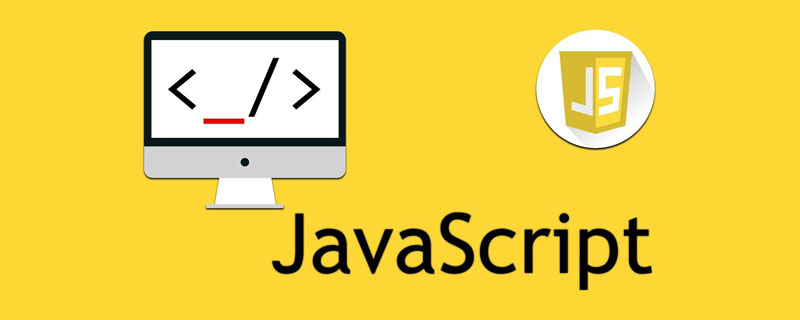
[Related recommendations: javascript video tutorial, web front-end】
Bubble event
- Event bubbling means that the event is initially received by the most specific element, and then propagates upward to less specific nodes.
- Event bubbling is enabled by default, but event bubbling can be controlled through js code.
Features:
When our event function is triggered, the event function will actually receive an event object.
When we execute the event.stopPropagation() method in our event function, the event bubbling ends here.
Not all types of events support event bubbling.
Event bubbling will only trigger event functions of the same type.
Two methods to prevent bubbling events
There are two methods to prevent bubbling events, one of which is an attribute and the other is a method.
cancelBubble
Set or return whether the event should be propagated to the upper level.
Syntax:
event.cancelBubble = true;
stopPropagation()
Prevent events from propagating further in the event stream.
Syntax:
event.stopPropagation();
Example: Bind click response functions to three objects that are mutually parent and child.
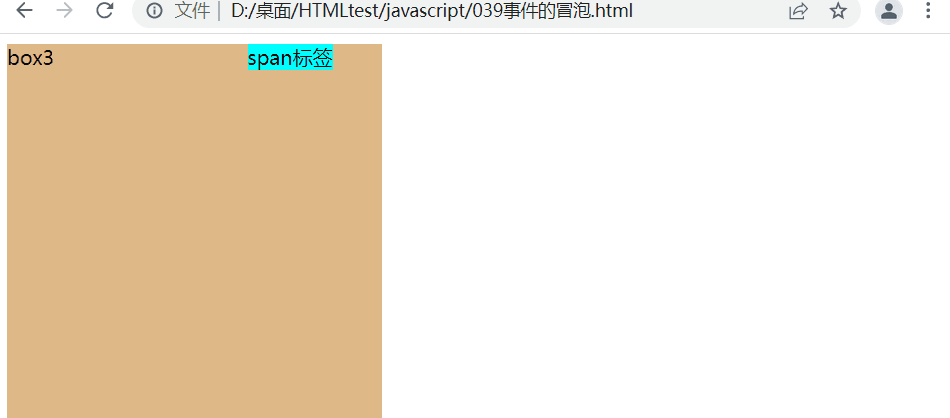
window.onload = function(){
var span = document.getElementById("sp");
span.onclick = function(){
alert('span标签');
}
var box = document.getElementById('box3');
box3.onclick = function(){
alert('box3');
}
var body = document.body;
body.onclick = function(){
alert('body');
}}Prevent bubbling of the box: 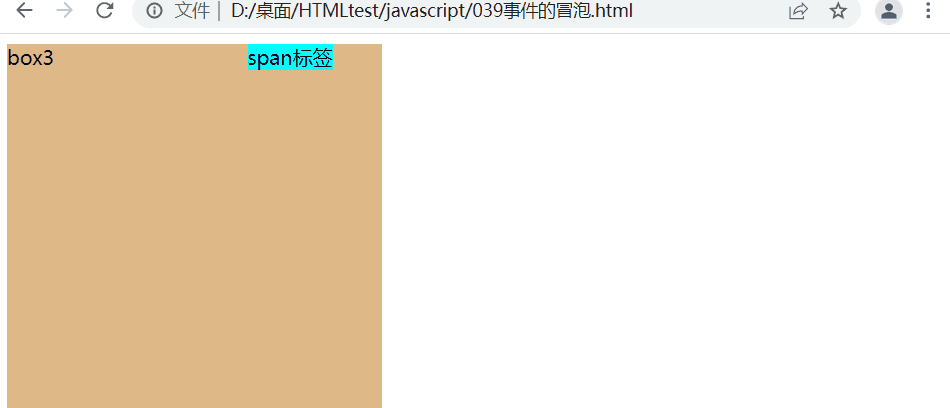 ##
##
window.onload = function(){
var span = document.getElementById("sp");
span.onclick = function(){
alert('span标签');
}
var box = document.getElementById('box3');
box3.onclick = function(event){
alert('box3');
event.stopPropagation();
}
var body = document.body;
body.onclick = function(){
alert('body');
}}ancestor element, so that when the event on the child element is triggered, it will bubble up to the ancestor element , thereby handling the event through the ancestor element's response event. Using bubbling and delegation, you can reduce the number of event bindings and improve program performance.
Get the clicked elementWhen we bind an event to the ancestor element, no matter which element we click on the ancestor element, the corresponding event will be triggered. We only hope that when we When an event is triggered only by clicking on an element within the ancestor element, a judgment condition needs to be given to determine whether it is the element we want to trigger the event. targetReturns the element that triggered the event.Syntax:event.taget;
##
window.onload = function(){
var ul = document.getElementById('ul1');
ul.onclick = function(event){
if(event.target.className == 'abq'){
alert('事件触发!!')
}
}
//添加超链接
document.getElementById('bt1').onclick = function(){
var li = document.createElement('li');
li.innerHTML = "<a>新建的标签</a>";
ul.appendChild(li);
}
}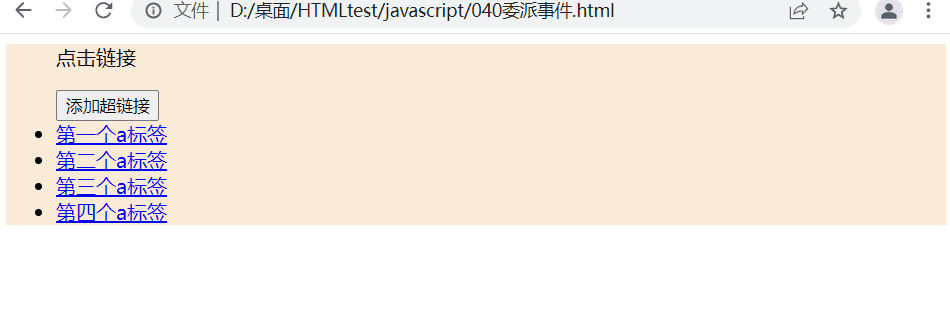 Bind events through addEventListener()
Bind events through addEventListener() Using this method, multiple identical event response functions can be bound to the same element.
Parameters:- callback function, which will be called when the event is triggered
- Whether to trigger the event in the capture phase requires a Boolean value, the default is false
- Use addEventListener() to bind multiple response functions to the same event of an element at the same time, so that when When an event is triggered, the response function will be executed in the order in which the function is bound!
window.onload = function(){
var bt = document.getElementById('bt1');
bt.addEventListener('click',function(){
alert('触发的第一个单击相应函数!')
},false);
bt.addEventListener('click',function(){
alert('触发的第二个单击相应函数!')
},false);
bt.addEventListener('click',function(){
alert('触发的第三个单击相应函数!')
},false);}事件的传播
- 关于事件的传播网景公司和微软公司有不同的理解:
微软公司认为事件应该是由内向外传播,也就是当事件触发时,应该先触发当前元素上的事件,然后再向当前元素的祖先元素上传播,也就说事件应该在冒泡阶段执行。
网景公司认为事件应该是由外向内传播的,也就是当前事件触发时,应该先触发当前元素的最外层的祖先元素的事件,然后在向内传播给后代元素。 - W3C综合了两个公司的方案,将事件传播分成了三个阶段:
- 捕获阶段
在捕获阶段时从最外层的祖先元素,向目标元素进行事件的捕获,但是默认此时不会触发事件。 - 目标阶段
事件捕获到目标元素,捕获结束开始在目标元素上触发事件。 - 冒泡阶段
事件从目标元素向他的祖先元素传递,依次触发祖先元素上的事件。

在冒泡阶段执行响应函数。默认第三个参数为false
window.onload = function(){
var box1 = document.getElementById('box1');
var box2 = document.getElementById('box2');
var box3 = document.getElementById('box3');
box1.addEventListener('click',function(){
alert('box1');
},false);
box2.addEventListener('click',function(){
alert('box2');
},false);
box3.addEventListener('click',function(){
alert('box3');
},false);
}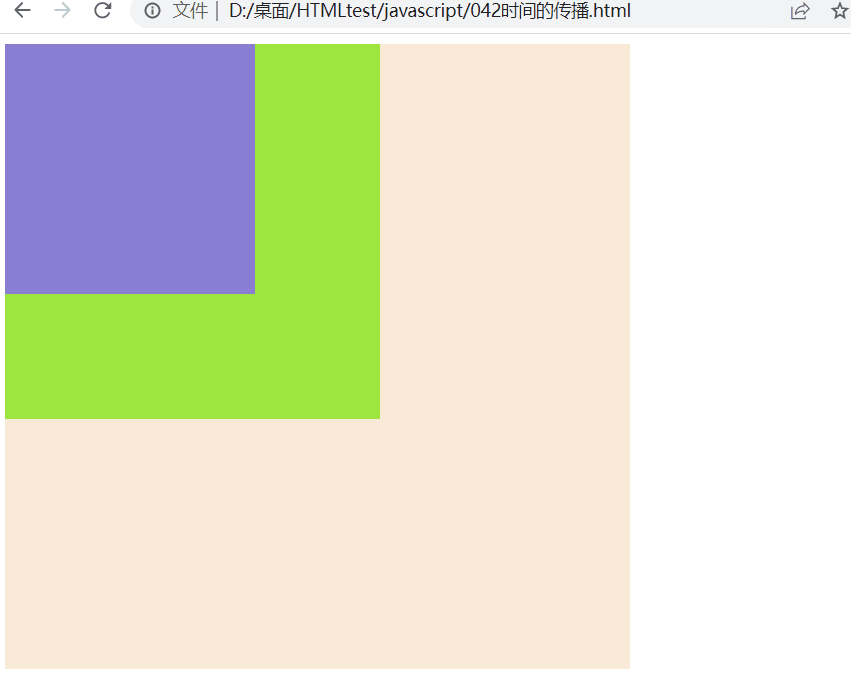
如果希望在捕获阶段就触发事件,可以将addEventListener()的第三个参数设置为true!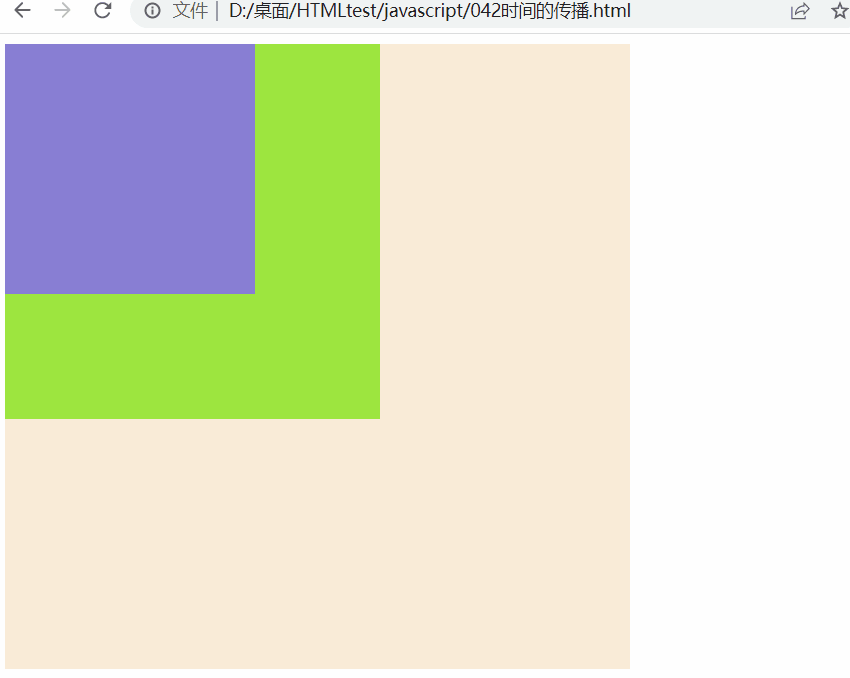
window.onload = function(){
var box1 = document.getElementById('box1');
var box2 = document.getElementById('box2');
var box3 = document.getElementById('box3');
box1.addEventListener('click',function(){
alert('box1');
},true);
box2.addEventListener('click',function(){
alert('box2');
},true);
box3.addEventListener('click',function(){
alert('box3');
},true);
}【相关推荐:javascript视频教程、web前端】
The above is the detailed content of Briefly understand the bubbling, delegation, binding and propagation of JavaScript events. For more information, please follow other related articles on the PHP Chinese website!

Hot AI Tools

Undresser.AI Undress
AI-powered app for creating realistic nude photos

AI Clothes Remover
Online AI tool for removing clothes from photos.

Undress AI Tool
Undress images for free

Clothoff.io
AI clothes remover

Video Face Swap
Swap faces in any video effortlessly with our completely free AI face swap tool!

Hot Article

Hot Tools

Notepad++7.3.1
Easy-to-use and free code editor

SublimeText3 Chinese version
Chinese version, very easy to use

Zend Studio 13.0.1
Powerful PHP integrated development environment

Dreamweaver CS6
Visual web development tools

SublimeText3 Mac version
God-level code editing software (SublimeText3)

Hot Topics
 1664
1664
 14
14
 1423
1423
 52
52
 1317
1317
 25
25
 1268
1268
 29
29
 1248
1248
 24
24
 How to implement an online speech recognition system using WebSocket and JavaScript
Dec 17, 2023 pm 02:54 PM
How to implement an online speech recognition system using WebSocket and JavaScript
Dec 17, 2023 pm 02:54 PM
How to use WebSocket and JavaScript to implement an online speech recognition system Introduction: With the continuous development of technology, speech recognition technology has become an important part of the field of artificial intelligence. The online speech recognition system based on WebSocket and JavaScript has the characteristics of low latency, real-time and cross-platform, and has become a widely used solution. This article will introduce how to use WebSocket and JavaScript to implement an online speech recognition system.
 WebSocket and JavaScript: key technologies for implementing real-time monitoring systems
Dec 17, 2023 pm 05:30 PM
WebSocket and JavaScript: key technologies for implementing real-time monitoring systems
Dec 17, 2023 pm 05:30 PM
WebSocket and JavaScript: Key technologies for realizing real-time monitoring systems Introduction: With the rapid development of Internet technology, real-time monitoring systems have been widely used in various fields. One of the key technologies to achieve real-time monitoring is the combination of WebSocket and JavaScript. This article will introduce the application of WebSocket and JavaScript in real-time monitoring systems, give code examples, and explain their implementation principles in detail. 1. WebSocket technology
 How to use JavaScript and WebSocket to implement a real-time online ordering system
Dec 17, 2023 pm 12:09 PM
How to use JavaScript and WebSocket to implement a real-time online ordering system
Dec 17, 2023 pm 12:09 PM
Introduction to how to use JavaScript and WebSocket to implement a real-time online ordering system: With the popularity of the Internet and the advancement of technology, more and more restaurants have begun to provide online ordering services. In order to implement a real-time online ordering system, we can use JavaScript and WebSocket technology. WebSocket is a full-duplex communication protocol based on the TCP protocol, which can realize real-time two-way communication between the client and the server. In the real-time online ordering system, when the user selects dishes and places an order
 How to implement an online reservation system using WebSocket and JavaScript
Dec 17, 2023 am 09:39 AM
How to implement an online reservation system using WebSocket and JavaScript
Dec 17, 2023 am 09:39 AM
How to use WebSocket and JavaScript to implement an online reservation system. In today's digital era, more and more businesses and services need to provide online reservation functions. It is crucial to implement an efficient and real-time online reservation system. This article will introduce how to use WebSocket and JavaScript to implement an online reservation system, and provide specific code examples. 1. What is WebSocket? WebSocket is a full-duplex method on a single TCP connection.
 JavaScript and WebSocket: Building an efficient real-time weather forecasting system
Dec 17, 2023 pm 05:13 PM
JavaScript and WebSocket: Building an efficient real-time weather forecasting system
Dec 17, 2023 pm 05:13 PM
JavaScript and WebSocket: Building an efficient real-time weather forecast system Introduction: Today, the accuracy of weather forecasts is of great significance to daily life and decision-making. As technology develops, we can provide more accurate and reliable weather forecasts by obtaining weather data in real time. In this article, we will learn how to use JavaScript and WebSocket technology to build an efficient real-time weather forecast system. This article will demonstrate the implementation process through specific code examples. We
 Simple JavaScript Tutorial: How to Get HTTP Status Code
Jan 05, 2024 pm 06:08 PM
Simple JavaScript Tutorial: How to Get HTTP Status Code
Jan 05, 2024 pm 06:08 PM
JavaScript tutorial: How to get HTTP status code, specific code examples are required. Preface: In web development, data interaction with the server is often involved. When communicating with the server, we often need to obtain the returned HTTP status code to determine whether the operation is successful, and perform corresponding processing based on different status codes. This article will teach you how to use JavaScript to obtain HTTP status codes and provide some practical code examples. Using XMLHttpRequest
 How to use insertBefore in javascript
Nov 24, 2023 am 11:56 AM
How to use insertBefore in javascript
Nov 24, 2023 am 11:56 AM
Usage: In JavaScript, the insertBefore() method is used to insert a new node in the DOM tree. This method requires two parameters: the new node to be inserted and the reference node (that is, the node where the new node will be inserted).
 JavaScript and WebSocket: Building an efficient real-time image processing system
Dec 17, 2023 am 08:41 AM
JavaScript and WebSocket: Building an efficient real-time image processing system
Dec 17, 2023 am 08:41 AM
JavaScript is a programming language widely used in web development, while WebSocket is a network protocol used for real-time communication. Combining the powerful functions of the two, we can create an efficient real-time image processing system. This article will introduce how to implement this system using JavaScript and WebSocket, and provide specific code examples. First, we need to clarify the requirements and goals of the real-time image processing system. Suppose we have a camera device that can collect real-time image data



